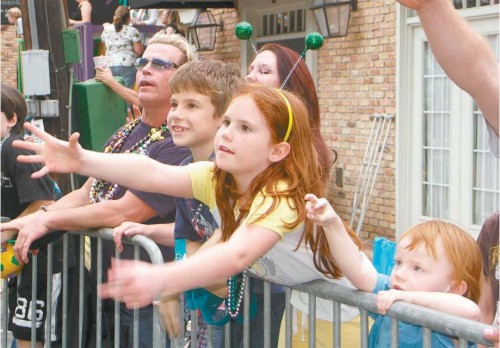
Theresa Adams
February 28, 2011Henry remembered for priorities
March 2, 2011What’s the purple, gold and green all about at Mardi Gras?
Why does Mardi Gras fall on a different date each year?
And why wear masks?
The Carnival season can be a foreign affair to newbies. The Gumbo Entertainment Guide looks to set the record straight for locals and guests experiencing the “Greatest Free Show on Earth” for the first time.
Carnival lasts approximately one to two months – starting on Jan. 6th, also known as the Twelfth Night, and ending on Ash Wednesday, which can be anywhere from Feb. 3rd to March 10th. This year, Fat Tuesday falls on March 8.
During this period, Carnival groups – or krewes – host a smattering of parties and functions. To add to the frenzied excitement, these festivities are not restricted to the merrymaking period of the season. The entire process of planning and celebrating is an all year job for most groups.
After all, the krewes are private, non-profit organizations whose members gather to plan their parade’s theme, costumes and unique throws. Members individually fund each Carnival club. While the parish issues permits for krewes to roll, paying for the floats, costumes and throws falls to the krewes.
During the year, each krewe member has his or her own respective duties to perform, though there is always a select few members who bear the brunt of the workload. Even the first “krewe” had its primary planners.
The word “krewe,” while coming from the French “crew,” supposedly originated from an organization called Ye Mystick Krewe of Comus, which was inspired by the Cowbellion de Rakin Society of Mobile, Ala. The six primary founders of Comus worked hard to bring the festive traditions to New Orleans, and in 1857 they held their first Torchlight Parade with John Milton’s “Paradise Lost” as the theme. Marching in masked merriment the parade was a staggering success and, over a century and a half later, modern day krewe’s still keep with many of the past traditions established by Ye Mystick Krewe of Comus.
Carnival krewes in the Tri-parishes range in size from roughly 30 members to as many as 600 or more. Some have been around for more than 50 years, such as the Krewe of Houmas, while others are still in their toddler stage.
Riders costume in the colors of the day: purple, symbolizing justice; green for faith; and gold for power. Rex, the King of Carnival, selected the colors in 1892. Gold and white can only be worn by royalty on parade day.
Ever wondered how the royals are chosen? It varies by krewe. Some krewes hold random drawings, while others seek volunteers and hold secret ballots. Mystic krewes keep their royals’ names secret until the day of the ball.
Balls are private affairs thrown by krewes for members and invited guests. Generally, these events are formal affairs – complete with tuxedos and ball gowns.
While balls are usually geared toward the adults, parades are a family affair.
The tradition of float riders tossing trinkets to the crowd dates back to the 1870s. Typical throws include beads, cups, doubloons and stuffed animals.
If you’re traveling with young children, babies especially, expect to be inundated. It’s a good idea to pack a bag for throws as you can quickly become loaded down with plastic, multi-colored beads and trinkets.
Hope that answers a few of your questions about Mardi Gras. Happy parading.








